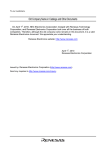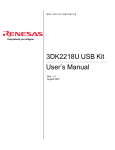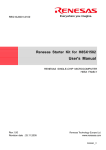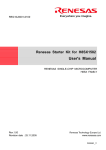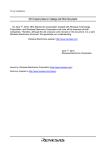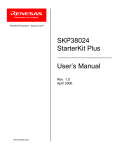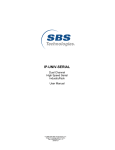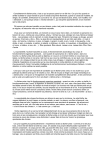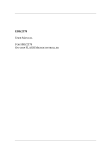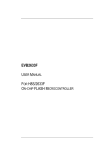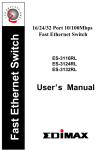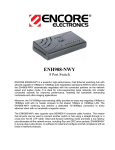Download 3DK1657 User Manual
Transcript
3DK1657 USER MANUAL FOR H8SX/1657 ON-CHIP FLASH MICROCONTROLLER Warning Check the silkscreen around the power jack (J9) for the minimum and maximum voltage input levels for this 3DK. Always use a centre positive supply for this board. DO NOT USE AN E6000 POWER SUPPLY with this 3DK Preface Cautions 1. This document may be, wholly or partially, subject to change without notice. 2. All rights reserved. No one is permitted to reproduce or duplicate, in any form, a part or this entire document without Renesas Technology Europe Limited's written permission. Trademarks General All brand or product names used in this manual are trademarks or registered trademarks of their respective companies or organisations. Document Information Product Code: D005463_11 Version: 1 Date: 23/11/2004 Copyright © Renesas Technology Europe Ltd. 2004. All rights reserved. Website: http://www.eu.renesas.com/ TABLE OF CONTENTS TABLE OF CONTENTS .......................................................................................................................................................3 1. POWER REQUIREMENTS ..........................................................................................................................................4 2. POWER – UP BEHAVIOUR ........................................................................................................................................4 3. PURPOSE ...............................................................................................................................................................4 4. BOARD LAYOUT ......................................................................................................................................................4 5. BLOCK DIAGRAM ....................................................................................................................................................5 6. USER CIRCUITRY ....................................................................................................................................................5 6.1. SWITCHES...........................................................................................................................................................5 6.2. LEDS ....................................................................................................................................................................6 6.3. POTENTIOMETER...............................................................................................................................................6 6.4. SERIAL PORT ......................................................................................................................................................6 6.5. JUMPERS.............................................................................................................................................................7 7. OSCILLATOR SOURCES ...........................................................................................................................................7 8. MODES ...................................................................................................................................................................8 8.1. BOOT MODE........................................................................................................................................................8 8.2. USER MODE ........................................................................................................................................................8 9. PROGRAMMING METHODS .......................................................................................................................................8 9.1. PORT PROGRAMMING.......................................................................................................................................9 9.2. FDM HEADER ......................................................................................................................................................9 9.3. E7 HEADER..........................................................................................................................................................9 9.4. OFF-BOARD PROGRAMMING............................................................................................................................9 10. HEADERS .............................................................................................................................................................10 10.1. MICON HEADERS..............................................................................................................................................10 10.2. GENERIC HEADERS .........................................................................................................................................12 11. CODE DEVELOPMENT ............................................................................................................................................12 11.1. OVERVIEW ........................................................................................................................................................12 11.2. MODE SUPPORT...............................................................................................................................................12 11.3. BREAKPOINT SUPPORT ..................................................................................................................................13 11.4. CODE LOCATED IN RAM..................................................................................................................................13 11.5. HMON CODE SIZE.............................................................................................................................................13 11.6. MEMORY MAP...................................................................................................................................................13 11.7. BAUD RATE SETTING.......................................................................................................................................14 11.8. INTERRUPT MASK SECTIONS.........................................................................................................................15 11.9. ADDITIONAL INFORMATION ............................................................................................................................15 1. POWER REQUIREMENTS All 3DK boards are centre positive with a 2.5mm barrel power jack. The diode, D1 provides reverse polarity protection. A 9V, centre positive supply is suitable for use with this board. Warning Check the silkscreen around the power jack (J9) for the minimum and maximum voltage input levels for this 3DK. The 3DK is neither under nor over voltage protected. Always use a centre positive supply for this board. DO NOT USE AN E6000 POWER SUPPLY with this 3DK 2. POWER – UP BEHAVIOUR The 3DK board has code pre-programmed into the Renesas microcontroller. On powering up the board, pressing switch 2 will cause the red user LEDs to flash. Switches 2 and 3 as well as the potentiometer can be used to modify the LED flashing pattern. 3. PURPOSE This 3DK board is an evaluation tool for Renesas microcontrollers. Features include: a. Renesas Microcontroller Programming b. User Code Debugging c. User Circuitry such as Switches, LEDs and potentiometer(s) d. User or Base Board Connectivity The 3DK board contains all the circuitry required for microcontroller operation. 4. BOARD LAYOUT The following diagram shows top layer component layout of the board. Note: The diagram below is for illustrative purposes and does not accurately reflect the 3DK detailed in this manual. RES J3 DEBUG U1 OFF USER SWITCHES ON MICON HEADER J2 MICON HEADER J3 MCU_SEL FLASH HEADER J4 19-WAY GENERIC HEADER J5 MCU SELECT SWITCH SW3 SERIAL PORT CLED8 CLED7 Renesas Microcontroller J8 CLED6 SW2 CLED5 CLED4 BOOTJ7 USER LEDS J12 CLED3 J2 POWER JACK SW1/BOOT J5 J6 CLED2 J9 CLED1 BOOT LED J1 BOOT MICON SINGLE TURN HEADER POTENTIOMETER J4 MICON HEADER J1 DEBUG HEADER 20-WAY GENERIC HEADER J6 RS232 Transceiver IC C 2004 Renesas Technology Europe LTD. BOOT LATCH U2 HC74 dual D-type logic U5 Crystal / Oscillator / Resonator Components / Footprints U6 5. BLOCK DIAGRAM Diagram x.1 is representative of the 3DK components and their connectivity. Power Jack & Regulator IC Generic Headers Microcontroller Boot mode pins Flash/Boot Header Micon Headers RESET pin Boot Circuitry RESn D-type latch Serial Connector BOOT & BOOTn signals IRQ/wakeup pin IRQ/wakeup pin Debug Header SW2 Potentiometer RES SW3 BOOT SWITCHES LEDs 8 Red LEDS 1 Green LED 6. USER CIRCUITRY 6.1. SWITCHES There are four switches located on the 3DK. These are: Switch SW1/BOOT Function This switch is used in conjunction with the RES switch to place the device in BOOT mode. SW2 This switch is connected via a 0R link to an IRQ line capable of waking up the microcontroller device from sleep mode. SW3 This switch is connected via a 0R link to another IRQ line capable of waking up the microcontroller device from sleep mode. RES This switch when pressed resets the 3DK microcontroller. NB. Refer to schematic for detailed connectivity information. Microcontroller IRQ0-A, Pin 72 (Port 1, pin 0) IRQ1-A , Pin73 (Port 1, pin 1) IRQ2-A, Pin 74 (Port 1, pin 2) RESn Regulator IC 6.2. LEDS There are nine LEDs on the 3DK board. The green BOOT LED indicates the device is in boot mode when lit. The eight red LEDs are connected to an IO port and will light when their corresponding port pin is set low. Table 6-1, below, shows the LED pin references and their corresponding microcontroller port pin connections. LED Reference (As shown on silkscreen) Microcontroller Port Pin function CLED1 CLED2 CLED3 CLED4 CLED5 CLED6 CLED7 CLED8 Microcontroller Pin Number PH0 PH1 PH2 PH3 PH4 PH5 PH6 PH7 53 54 55 56 58 59 60 61 Table 6-1:LED Port 6.3. POTENTIOMETER A single turn potentiometer is connected to AN0 of the microcontroller. This may be used to vary the input analog voltage value to this pin between AVCC and Ground. 6.4. SERIAL PORT The microcontroller programming serial port (SCI4) is connected to the D–type connector J8 via an RS232 transceiver. A secondary microcontroller serial port (SCI1) is connected to generic header, J6 via the second channel of the RS232 transceiver. The serial baud rates supported by this 3DK are shown below. Note: these values are calculated from the frequency value of the main oscillating source fitted by default on this 3DK. Baud Rate Register Settings for Serial Communication Rates Values are calculated for 29.4984MHz clock SMR Setting: Comm. Baud 0 1 2 3 BRR setting Actual Rate ERR (%) BRR setting Actual Rate ERR (%) BRR setting Actual Rate ERR (%) BRR setting Actual Rate ERR (%) 110 invalid invalid invalid 300 invalid invalid invalid invalid invalid invalid invalid invalid invalid 64 111 0.70 invalid invalid invalid 95 300 0.00 23 300 0.00 1200 invalid invalid invalid 95 1200 0.00 23 1200 0.00 5 1200 0.00 2400 0.00 47 2400 0.00 11 2400 0.00 2 2400 0.00 2400 191 4800 95 4800 0.00 23 4800 0.00 5 4800 0.00 1 3600 -25.00 9600 47 9600 0.00 11 9600 0.00 2 9600 0.00 invalid invalid invalid 19200 23 19200 0.00 5 19200 0.00 1 14400 -25.00 invalid invalid invalid 38400 11 38400 0.00 2 38400 0.00 invalid invalid invalid invalid invalid invalid 57600 7 57600 0.00 1 57600 0.00 invalid invalid invalid invalid invalid invalid 115200 3 115200 0.00 0 115200 0.00 invalid invalid invalid invalid invalid invalid Table 6-2 : BRR Settings This serial port may be used as a debugging communication port or as a normal serial communication port when the device is in user mode. 5 4 9 3 8 2 7 1 6 Female serial connector showing pin numbering Power Jack 6.5. JUMPERS Table 6-3 below describes the function of the 2-Pin jumpers contained on this 3DK board. 2-Pin Jumper Settings Reference Jumper Function Fitted Alternative (Removed) Footprint for jumper only/Jumper pins fitted J10 RX Disable PRXD from the RS232 device to U1 is enabled. This enables serial port communication. Disabled. This allows the FDM to program the microcontroller Jumper pins fitted J11 UVCC power Measurement Bypasses R11, a 1206 0R resistor, for current measurement R11 must be fitted to power UVCC Footprint only J13 User Boot A transition to user mode is made once a boot switch sequence is performed by the user A transition to boot mode is made once a boot switch sequence is performed by the user J14 Regulator Bypass Bypasses the regulator; power to board is taken directly from external supply (additionally R87 must be fitted and R85 removed) Board supply is taken via regulator Table 6-4: 2-Pin jumpers 7. OSCILLATOR SOURCES A ceramic resonator is fitted on the 3DK and used to supply the main clock input to the Renesas microcontroller. Table 7-1 details the oscillators that are fitted and alternative footprints provided on this 3DK: Component Resonator (X1) Crystal (X2) Crystal (X3) Subclock Details Footprint Only &/or fitted* 14.7458MHz Footprint Only &/or fitted* 14.745MHz Footprint only 14.7456MHz recommended value (HC/49U package) 115200 (4.1mm x 4.7mm package) 115200 (low profile package 5mm x 7mm x 1.3mm) 115200 None Table 7-1: Oscillators / Resonators * Either X1 or X2 will be fitted on this board. Warning: When replacing the default oscillator with that of another frequency, the FDT programming kernels supplied will need rebuilding. The supplied HMON debugging monitor will not function. The user is responsible for code written to support operating speeds other than the default. See the HMON user manual for details of making the appropriate modifications in the code to accommodate different operating frequencies. 8. MODES The 3DK supports User mode, Boot mode and User Boot mode. User mode may be used to run and debug user code, while Boot mode may only be used to program the Renesas microcontroller with program code. User Boot mode can only be used to program the User Mat (the main area, 768Kbytes, of Flash ROM on the device). It does not support programming of the user boot area. User Boot mode is used to run a user bootloader program stored in the user boot MAT (the smaller area, 8Kbytes, of Flash ROM). To program the user boot MAT, the device must be in Boot mode. Further details of programming the MATs are available in the H8SX/1657 hardware manual. To enter boot mode, press and hold the boot button so that the mode pins are held in their boot states while reset is pressed and released. Then release the boot button. The BOOT LED will be illuminated to indicate that the microcontroller is in boot mode. 8.1. BOOT MODE The boot mode settings for this 3DK are shown in Table 8-1 below: MD0 1 1 MD1 1 0 MD2 1 0 LSI State after Reset End User Mode Boot Mode Table 8-1: Mode pin settings 8.2. USER BOOT MODE A Note on Mats: The H8SX/1657 possesses two distinct areas of Flash, User MAT (768KByte) and User Boot MAT (8KByte). The User Boot MAT is a separate area of FLASH from User MAT, intended to hold user boot code. A custom boot stub could be programmed into User Boot MAT which allows programming and erasing of the User MAT in User Mode, without erasing the contents of the User Boot MAT. Once User Boot Mode is entered, code contained in the User Boot MAT is executed. This differs to Boot mode, as Boot mode erases all User MAT and requires an auto-baud on a fixed SCI port to be performed. The existence of the user boot Mat therefore allows an alternative communications port to be used for further code download to the User MAT. Programming of the user boot mat may only be performed in boot mode. The user may place the H8SX/1657 device provided on a 3DK1657 board in user boot mode by fitting jumper J13. The Boot procedure must then be performed for entry into user boot mode. The Boot LED should light, suggesting a transition to user boot mode. The user boot mode settings for this 3DK are shown in Table 8-1 below: MD0 0 MD1 1 MD2 0 LSI State after Reset End User Boot Mode Table 8-2: Mode pin settings 8.3. USER MODE For the device to enter User Mode, reset must be held active while the microcontroller mode pins are held in states specified for User Mode operation. 100K pull up and pull down resistors are used to set the pin states during reset. The H8SX/1657 supports 4 user modes. The memory map in all of these modes is 16Mbyte in size. The default user mode for 3DK1657 is 7. 9. PROGRAMMING METHODS All of the Flash ROM on the device (i.e. both MATs) can be programmed when the device is in Boot mode. Once in boot mode, the bootloader program pre-programmed into the microcontroller executes and attempts a connection with a host (for example, a PC). The host, on establishing a connection with the microcontroller, may then transmit program data to the microcontroller via the appropriate programming port. Table 9-1below shows the programming port for this Renesas Microcontroller and its associated pins Programming Port Table – Programming port pins and their 3DK signal names SCI4 TXD4, PIN 89 RXD4, PIN 90 SCK4, PIN 91 3DK Signal Name PTXD PRXD PSCK Table 9-1: Serial Port Boot Channel 9.1. PORT PROGRAMMING The microcontroller must enter boot mode for programming, and the programming port must be connected to a host for program download. To execute the boot transition, and allow programs to download to the microcontroller, the user must perform the following procedure: 1. 2. 3. 4. Connect a 1:1 serial cable between the host PC and the 3DK board Depress the RESET switch and keep this held down Depress the BOOT switch once, and release Release the RESET switch 9.2. FDM HEADER The Renesas FDM (Flash Debug Module) is a USB based programming tool for control and programming of Renesas microcontrollers, available separately from Renesas. The 3DK serial programming signals PTXD, PRXD, PSCK and the microcontroller mode pins as well as the microcontroller reset signal are all connected to this header. The FDM, when connected to the Flash Programming header, is therefore capable of forcing the microcontroller into boot mode, programming and resetting the 3DK microcontroller. To utilise this header the user must make the following changes to the board configuration. 1. Jumper link J10 must be removed. 9.3. E7, E10A AND E10T HEADERS This device does not currently support any of the E7, E10A or E10T programming tools. 9.4. OFF-BOARD PROGRAMMING All 3DKs are capable of programming an alternative microcontroller on a secondary board. The user is responsible for providing this second board containing the alternative microcontroller, its supporting circuitry and an FDM or FoUSB header for the microcontroller. To program the alternative microcontroller, the user should perform the following steps • • Connect a cable between the 3DK programming header and that located on the secondary board. Slide switch MCU_SEL to the off-board programming position (OFF). This holds the microcontroller on the 3DK in reset, preventing it from being programmed. 10. HEADERS 10.1. MICON HEADERS Table 10-1 to Table 10-4 shows the micon headers and their corresponding microcontroller connections. The header pins connect directly to the micon pin unless otherwise stated. Table 10-1: J1 J1 Pin 1 3 5 7 9 11 13 15 17 19 21 23 25 27 29 Circuit Net Name PB1 PB3 PF7 PF5 PF3 PF2 PF0 PE6 GROUND BOARD_VCC PE2 PE0 PD6 PD5 PD3 U1 pin number 1 3 5 7 9 11 13 15 17 19 21 23 25 27 29 J1 pin number 2 4 6 8 10 12 14 16 18 20 22 24 26 28 30 Circuit Net Name PB2 MD2 PF6 PF4 GROUND PF1 PE7 PE5 PE4 PE3 PE1 PD7 GROUND PD4 PD2 U1 pin number 2 4 6 8 10 12 14 16 18 20 22 24 26 28 30 Table 10-2: J2 J2 Pin 1 3 5 7 9 11 13 15 17 19 21 23 25 27 29 Circuit Net Name PD1 EMLE P21 P23 RXD1 P27 P30 P31 P33 P35 P37 PH0 PH2 GROUND PH5 U1 pin number 31 33 35 37 39 41 43 45 47 49 51 53 55 57 59 J2 pin number 2 4 6 8 10 12 14 16 18 20 22 24 26 28 30 Circuit Net Name PD0 P20 P22 P24 TXD1 GROUND BOARD_VCC P32 P34 P36 NMI PH1 PH3 PH4 PH6 U1 pin number 32 34 36 38 40 42 44 46 48 50 52 54 56 58 60 Table 10-3: J3 J3 Pin 1 3 5 7 9 11 13 15 17 19 21 23 25 27 29 Circuit Net Name PH7 PI0 PI2 GROUND PI5 PI7 P11 P13 RESn P14 WDTOVFn XTAL BOARD_VCC P17 PTXD U1 pin number 61 63 65 67 69 71 73 75 77 79 81 83 85 87 89 J3 pin number 2 4 6 8 10 12 14 16 18 20 22 24 26 28 30 Circuit Net Name Board_Vcc PI1 PI3 PI4 PI6 P10 P12 GROUND NC (Vcl Pin) P15 GROUND EXTAL P16 STBYn P61 U1 pin number 62 64 66 68 70 72 74 76 78 80 82 84 86 88 90 Table 10-4: J4 J1 Pin 1 3 5 7 9 11 13 15 17 19 21 23 25 27 29 Circuit Net Name P62 P63 P64 MD0 P51 CON_AVCC CON_AVSS CON_VREF P56 MD1 PA1 PA3 PA5 GROUND BOARD_VCC U1 pin number 91 93 95 97 99 101 103 105 107 109 111 113 115 117 119 J1 pin number 2 4 6 8 10 12 14 16 18 20 22 24 26 28 30 Circuit Net Name NC (PLL Pin) NC (PLL Pin) P65 P50 P52 P53 P54 P55 P57 PA0 PA2 PA4 PA6 PA7 PB0 U1 pin number 92 94 96 98 100 102 104 106 108 110 112 114 116 118 120 10.2. GENERIC HEADERS Table 10-5below shows the generic header connections 19 way generic Header Pin Generic Number Header Name 1 Supply 3DK Signal Name 20 way generic Header Supply Micon Pin N\A Generic Header Pin Name Number 1 IOPORT_TXD 3DK Signal Name IOPORT_TXD Micon Pin N\A 2 Xin CON_EXTAL N\A 2 IOPORT_RXD IOPORT_RXD N\A 3 Vcc Board_VCC N\A 3 IOPORT_T1 IOPORT_T1 48 4 Vss Ground N\A 4 IOPORT_T2 IOPORT_T2 49 5 Vcc Board_VCC N\A 5 IOPORT_T3 IOPORT_T3 50 6 Vss Ground N\A 6 IOPORT_T4 IOPORT_T4 51 7 AVcc AVCC 101 7 IOPORT_U NC N\A 8 AVss AVSS 103 8 IOPORT_V NC N\A 9 Vref VREF 105 9 IOPORT_W NC N\A 10 AN0 PIN98 98 10 IOPORT_0 IOPORT_0 53 11 AN1 PIN99 99 11 IOPORT_1 IOPORT_1 54 12 AN2 PIN100 100 12 IOPORT_2 IOPORT_2 55 13 AN3 PIN102 102 13 IOPORT_3 IOPORT_3 56 14 DAC0 PIN107 107 14 IOPORT_4 IOPORT_4 58 15 DAC1 PIN108 108 15 IOPORT_5 IOPORT_5 59 16 SCL N\A N\A 16 IOPORT_6 IOPORT_6 60 17 SDA N\A N\A 17 IOPORT_7 IOPORT_7 61 18 CTX N\A N\A 18 /Reset RESn 77 19 CRX N\A N\A 19 IOPORT_INT NMIn 52 20 VSS GROUND N\A Table 10-5: Generic Headers * Connected via a DNF 0R Link, refer to schematic for further details. 11. CODE DEVELOPMENT 11.1. OVERVIEW Note: For all code debugging using Renesas software tools, the 3DK board must either be connected to a PC serial port via a serial cable or a PC USB port via an FDM (Flash Debug Module). The HMON embedded monitor code is modified for each specific 3DK Renesas Microcontroller. HMON enables HEW to establish a serial connection to the 3DK microcontroller, and control code execution on the microcontroller. Breakpoints may be set in memory to halt code execution at a specific point. The code may be started from this point. The HMON embedded monitor code must be compiled with user software and downloaded to the 3DK, allowing the users’ code to be debugged within HEW. 11.2. MODE SUPPORT The HMON library is built to support 16Mbyte advanced Mode for the H8SX family only. 11.3. BREAKPOINT SUPPORT The device has no break controller. No breakpoints can be located in ROM code. However, code located in RAM may have multiple breakpoints limited only by the size of the On-Chip RAM. 11.4. CODE LOCATED IN RAM Double clicking in the breakpoint column in the code sets the breakpoint. Breakpoints will remain unless they are double clicked to remove them. 11.5. HMON CODE SIZE HMON is built along with the debug code. Certain elements of the HMON code must remain at a fixed location in memory. The following table details the HMON components and their size and location in memory. For more information, refer to the map file when building code. Section Description Start Location Size (H’bytes) RESET_VECTOR HMON Reset Vector (Vector 0) Required for Startup of HMON HMON Serial Port Vectors (Vector 160, 161, 162, 163) Used by HMON when EDK is configured to connect to the default serial port. HMON Code HMON Constant Data HMON Uninitialised data H’ 0000 0000 4 H’0000 0280 F H’0000 3000 H’0000 5730 H’00FF 6494 2730 134 21F FDT Kernel. This is at a fixed location and must not be moved. Should the kernel need to be moved it must be re-compiled. Pointer used by HMON to point to the start of user code. H’0000 1000 E64 H’0000 0800 4 SCI_VECTORS PHMON CHMON BHMON UGenU CUser_Vectors 11.6. MEMORY MAP The memory map shown in this section visually describes the locations of program code sections related to HMON, the FDT kernels and the supporting code within the ROM/RAM memory areas of the microcontroller. H'0000 Vectors H'0800 H'0803 H'1000 RESET Vector H'0000 H'0003 SCI Vectors H'0280 H'028B CUser_Vectors UGenU FDT Kernel H'1E63 H'3000 PHMON CHMON H'5863 On-Chip FLASH ROM H'BFFFF H'FF6000 On-Chip RAM H'FF6494 BHMON H'FF66B2 H'FFBE00 Stack H'FFBFFF H'FFFB80 H'FFFFFF Internal I/O REGISTERS 11.7. BAUD RATE SETTING HMON is initially set to connect at 115200 Baud. The value set in the baud rate register for the microcontroller must be altered if the user wishes to change either the serial communication baud rate of the serial port or the operating frequency of the microcontroller. This value is held in the HMONserialconfiguser.c file, as SCI_CFG_BRR (see the Serial Port section for baud rate register setting values). The project must be re-built and the resulting code downloaded to the microcontroller once the BRR value is changed. Please refer to the HMON User Manual for further information. 11.8. INTERRUPT MASK SECTIONS HMON has an interrupt priority of 6. The serial port has an interrupt priority of 7. Modules using interrupts should be set to lower than this value (6 or below), so that serial communications and debugging capability is maintained. 11.9. ADDITIONAL INFORMATION For details on how to use High-performance Embedded Workshop (HEW), with HMON, refer to the HEW manual available on the CD or from the web site. For information about the H8SX/1657 series microcontrollers refer to the H8SX/1657 Series Hardware Manual For information about the H8SX/1657 assembly language, refer to the H8 Series Programming Manual Further information available for this product can be found on the Renesas web site at: http://www.eu.renesas.com/tools General information on Renesas Microcontrollers can be found at the following URLs. Global: http://www.renesas.com/















